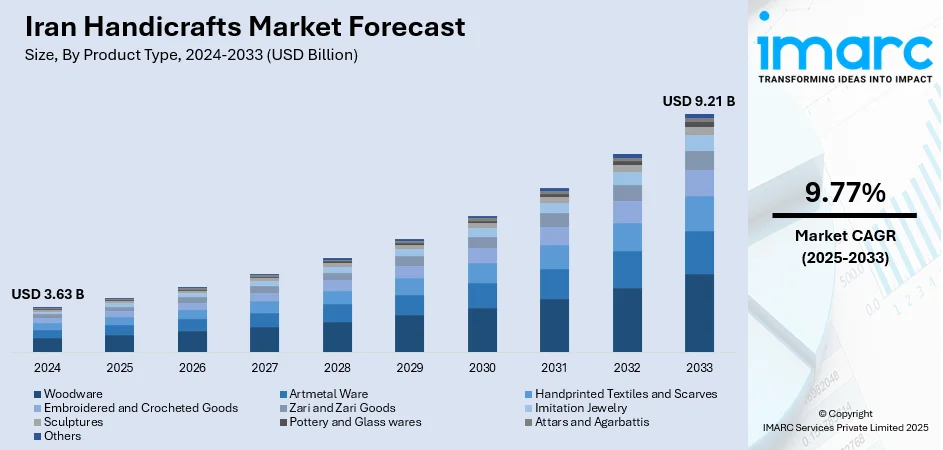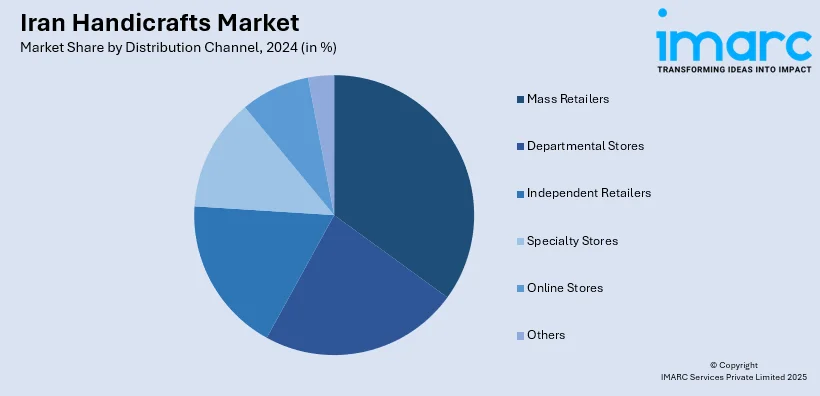
Iran Handicrafts Market Size, Share, Trends and Forecast by Product Type, Distribution Channel, End Use, and Region, 2025-2033
Iran Handicrafts Market Overview:
The Iran handicrafts market size reached USD 3.63 Billion in 2024. Looking forward, the market is projected to reach USD 9.21 Billion by 2033, exhibiting a growth rate (CAGR) of 9.77% during 2025-2033. Rich cultural history, rising demand for traditional handcrafted goods, increased interest in Iranian art worldwide, and government support for handicraft preservation are some of the factors driving the market. The growth of internet platforms and increasing disposable incomes have also helped to increase the Iran handicrafts market share.
|
Report Attribute
|
Key Statistics
|
|---|---|
|
Base Year
|
2024
|
|
Forecast Years
|
2025-2033
|
|
Historical Years
|
2019-2024
|
| Market Size in 2024 | USD 3.63 Billion |
| Market Forecast in 2033 | USD 9.21 Billion |
| Market Growth Rate 2025-2033 | 9.77% |
Iran Handicrafts Market Trends:
Cultural Heritage and Craftsmanship
Iran's rich cultural legacy is a major factor in the market expansion for Iranian handicrafts. Persian carpets, ceramics, and textiles are examples of traditional Iranian handicrafts that are well known for their exquisite designs and superior quality. The market gains from the rich tradition of workmanship in the country, as regional craftspeople continue to create classic pieces employing techniques that have been handed down through the years. The demand for these distinctive works of art has increased due to the recognition of Iranian art in global markets, establishing Iran as a leader in handicrafts. The revival of traditional techniques and emphasis on preserving these crafts has also gained considerable momentum, contributing to the Iran handicrafts market growth. For instance, in October 2024, the 14th Handicrafts and Traditional Arts Exhibition in Kermanshah, Iran, featured 220 artists showcasing crafts from 30 provinces. The event highlighted Kermanshah’s rich history of traditional arts, including kilim weaving and tambourine craft. The province has invested in training 500 artisans and allocated $800,000 in loans for home-based handicraft jobs.

To get more information on this market, Request Sample
Government Initiatives and Export Growth
In order to encourage artisans and promote Iranian handicrafts internationally, the Iranian government has put in place a number of programs to support the handicrafts sector. Demand has grown dramatically both domestically and internationally as a result of initiatives like setting up trade shows, offering financial incentives, and setting up venues for craftspeople to market their goods. The government has facilitated the export potential of handicrafts by acknowledging their significance as a component of the country's cultural character. For instance, in the first five months of 2024, Hamadan's handicraft exports reached $10.38 Million, with 90% from informal and suitcase trade. The province's top exports include ceramics, glassware, traditional embroidery, and mosaic work, primarily to Iraq, Azerbaijan, Turkey, and the Netherlands. The local government is enhancing marketing and product distribution efforts. Internationally, the demand for authentic and culturally rich products has surged, particularly in markets such as Europe, the US, and Asia. These initiatives have been crucial in bolstering the Iran handicrafts market share, leading to a rise in exports and global visibility for Iranian artisans.
Iran Handicrafts Market Segmentation:
IMARC Group provides an analysis of the key trends in each segment of the market, along with forecasts at the region/country level for 2025-2033. Our report has categorized the market based on product type, distribution channel, and end use.
Product Type Insights:
- Woodware
- Artmetal Ware
- Handprinted Textiles and Scarves
- Embroidered and Crocheted Goods
- Zari and Zari Goods
- Imitation Jewelry
- Sculptures
- Pottery and Glass Wares
- Attars and Agarbattis
- Others
The report has provided a detailed breakup and analysis of the market based on the product type. This includes woodware, artmetal ware, handprinted textiles and scarves, embroidered and crocheted goods, zari and zari goods, imitation jewelry, sculptures, pottery and glass wares, attars and agarbattis, and others.
Distribution Channel Insights:

- Mass Retailers
- Departmental Stores
- Independent Retailers
- Specialty Stores
- Online Stores
- Others
A detailed breakup and analysis of the market based on the distribution channel have also been provided in the report. This includes mass retailers, departmental stores, independent retailers, specialty stores, online stores, and others.
End Use Insights:
- Residential
- Commercial
The report has provided a detailed breakup and analysis of the market based on the end use. This includes residential and commercial.
Regional Insights:
- Tehran
- Khuzestan
- Bushehr
- Esfahan
- Khorasan
- Others
The report has also provided a comprehensive analysis of all the major regional markets, which include Tehran, Khuzestan, Bushehr, Esfahan, Khorasan, and others.
Competitive Landscape:
The market research report has also provided a comprehensive analysis of the competitive landscape. Competitive analysis such as market structure, key player positioning, top winning strategies, competitive dashboard, and company evaluation quadrant has been covered in the report. Also, detailed profiles of all major companies have been provided.
Iran Handicrafts Market News:
- In May 2025, Anzali Free Zone in Iran became a handicrafts export hub for the Caspian Sea littoral states. Iran's deputy minister for handicrafts highlighted plans to establish a specialized customs administration, standardize products, and boost artisans' business skills. The region will host a large handicrafts campus and a cargo flight route to export products, with a focus on basket weaving.
- In October 2024, Iran and Turkmenistan organized a joint festival in Ashgabat, focusing on tourism, handicrafts, and music. The event featured travel highlights, handicraft workshops, and live performances. It aimed to strengthen cultural ties and boost tourism between the two nations, celebrating their historic and cultural connections.
Iran Handicrafts Market Report Coverage:
| Report Features | Details |
|---|---|
| Base Year of the Analysis | 2024 |
| Historical Period | 2019-2024 |
| Forecast Period | 2025-2033 |
| Units | Billion USD |
| Scope of the Report |
Exploration of Historical Trends and Market Outlook, Industry Catalysts and Challenges, Segment-Wise Historical and Future Market Assessment:
|
| Product Types Covered | Woodware, Artmetal Ware, Handprinted Textiles and Scarves, Embroidered and Crocheted Goods, Zari and Zari Goods, Imitation Jewelry, Sculptures, Pottery and Glass Wares, Attars and Agarbattis, Others |
| Distribution Channels Covered | Mass Retailers, Departmental Stores, Independent Retailers, Specialty Stores, Online Stores, Others |
| End Uses Covered | Residential, Commercial |
| Regions Covered | Tehran, Khuzestan, Bushehr, Esfahan, Khorasan, Others |
| Customization Scope | 10% Free Customization |
| Post-Sale Analyst Support | 10-12 Weeks |
| Delivery Format | PDF and Excel through Email (We can also provide the editable version of the report in PPT/Word format on special request) |
Key Questions Answered in This Report:
- How has the Iran handicrafts market performed so far and how will it perform in the coming years?
- What is the breakup of the Iran handicrafts market on the basis of product type?
- What is the breakup of the Iran handicrafts market on the basis of distribution channel?
- What is the breakup of the Iran handicrafts market on the basis of end use?
- What is the breakup of the Iran handicrafts market on the basis of region?
- What are the various stages in the value chain of the Iran handicrafts market?
- What are the key driving factors and challenges in the Iran handicrafts market?
- What is the structure of the Iran handicrafts market and who are the key players?
- What is the degree of competition in the Iran handicrafts market?
Key Benefits for Stakeholders:
- IMARC’s industry report offers a comprehensive quantitative analysis of various market segments, historical and current market trends, market forecasts, and dynamics of the Iran handicrafts market from 2019-2033.
- The research report provides the latest information on the market drivers, challenges, and opportunities in the Iran handicrafts market.
- Porter's five forces analysis assist stakeholders in assessing the impact of new entrants, competitive rivalry, supplier power, buyer power, and the threat of substitution. It helps stakeholders to analyze the level of competition within the Iran handicrafts industry and its attractiveness.
- Competitive landscape allows stakeholders to understand their competitive environment and provides an insight into the current positions of key players in the market.
Need more help?
- Speak to our experienced analysts for insights on the current market scenarios.
- Include additional segments and countries to customize the report as per your requirement.
- Gain an unparalleled competitive advantage in your domain by understanding how to utilize the report and positively impacting your operations and revenue.
- For further assistance, please connect with our analysts.
 Request Customization
Request Customization
 Speak to an Analyst
Speak to an Analyst
 Request Brochure
Request Brochure
 Inquire Before Buying
Inquire Before Buying




.webp)




.webp)












